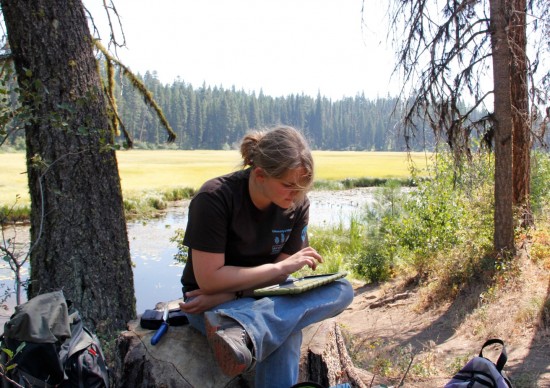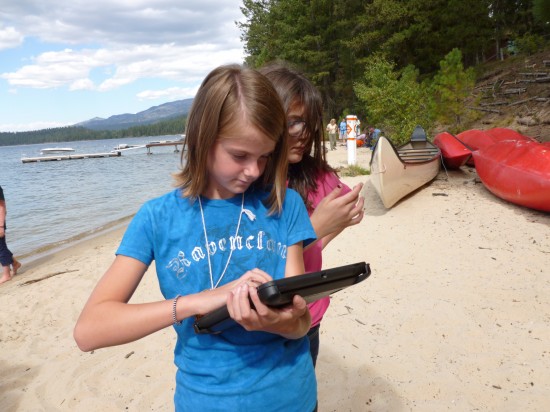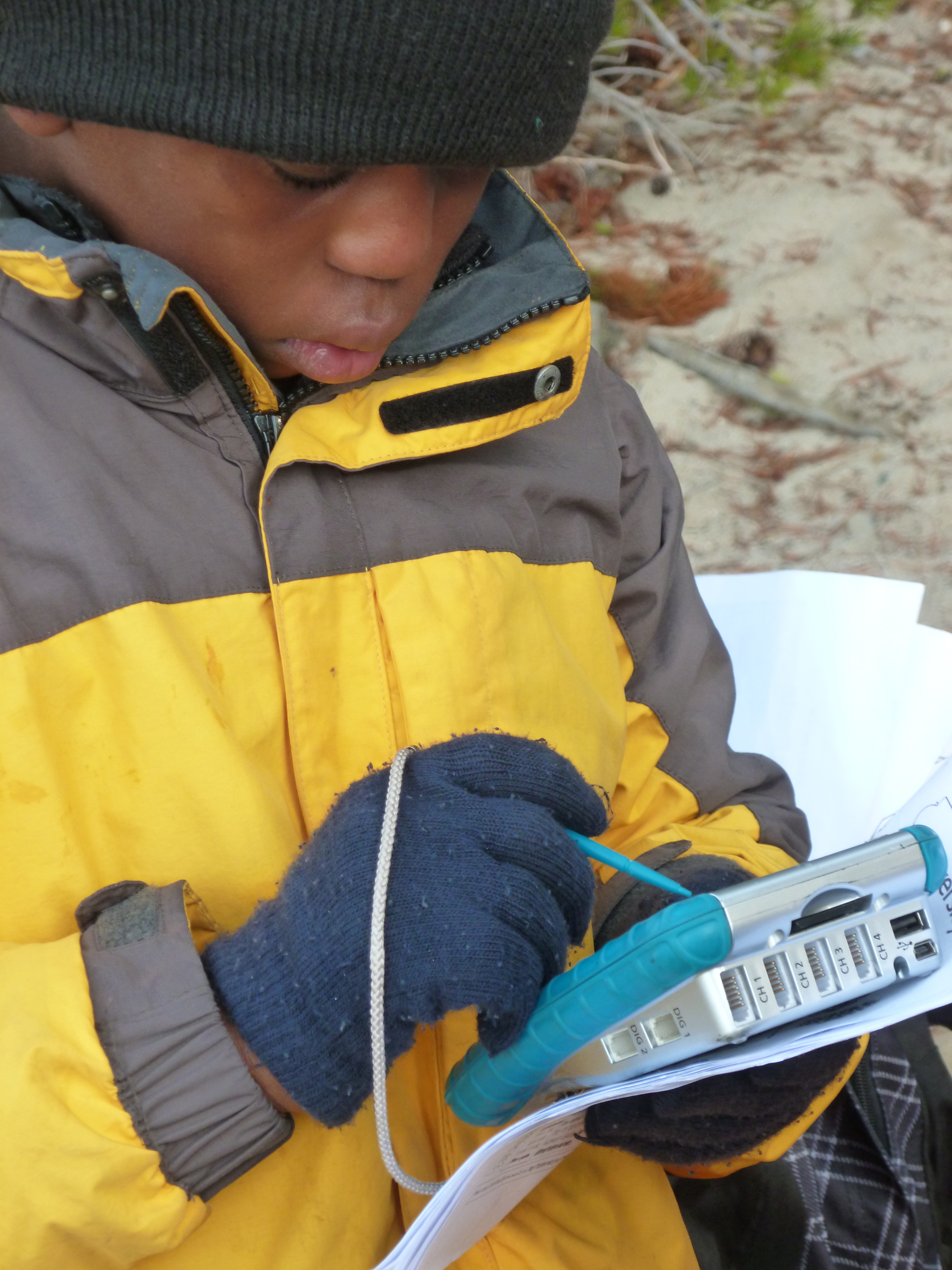Combining the Strengths of Adventure Learning and Place-based Education
How re-conceptualizing the role of technology in place-based education enhances place responsive pedagogies through technology.
by R. Justin Hougham,
Karla C. Bradley Eitel and
Brant G. Miller
University of Idaho
Technology in Place-based Environmental Education
In the 21st century, students need to be able to communicate through a variety of mediums, be critical consumers of vast amounts of written and visual data, and possess skills and dispositions for addressing complex global issues with local implications, such as climate change. As practitioners of residential place-based environmental education that seeks to foster scientific literacy and connect students to place, we have traveled cautiously into the cyber-enabled landscape because of a deeply rooted feeling that technology can be a distraction to students’ deep observation in the field. That said, we are exploring the idea that technology may also provide tools that can transform our ability to connect students to place. Imagine this scenario: a field teacher uses a picture to show students a concept diagram of the water cycle; the students’ attention is on the image rather than on the place. Instead, what if cameras were used to observe water in the immediate environment, thus, cataloging water in as many phases as the students can find? Digital voice recorders could be employed to capture the haunting, ancient whale-like sounds of liquid water beneath the frozen lake; In addition, students collect and upload data about the quality or quantity of the water. This data could then be visualized within an observational database used by scientists to better understand water resources at a hyper-local scale, thereby contributing to better predictive models that inform watershed and fisheries management. In the first scenario, an age-old “technology” distracts from deep observation, but in the re-imagined scenario observation is enhanced and transformed.
It is our belief that, when used wisely, technology can enable a deeper connection to material through a multi-media approach to observing, describing places, and visualizing data collected on site. 21st century educators are increasingly being asked to integrate cyber-based tools into programs and we propose that they do so in a way that increases students’ ability to explore the socio-ecological places where they live. One way of doing this is through the AL@ approach.
 Merging Technology, Place and Change
Merging Technology, Place and Change
AL@ is a re-conceptualization of the role of technology in place-based education that enhances place responsive pedagogies through technology. Adventure Learning (AL) is a hybrid online curricular approach we have explored within the context of a residential environmental education program at the McCall Outdoor Science School (MOSS). We are naming this combined theoretical frameworks of AL and PBE, Adventure Learning @ (AL@). The AL@ nomenclature is intended to express at once the online world (@) as well as the treatment offered here of AL that situates the framework in relation to the principles of PBE (as in Adventure Learning at…). Students and teachers become experts in their own experiences through studies of the places where they live, using freely available software and low cost technology. Further, we explore ways in which AL@ enhances our place-based programs by supporting connection and communication beyond the spatial and temporal boundaries of student experience. Finally, by students authoring their experience, honoring multiple world views, the hybridized approach offered through AL@ equips students and teachers to engage in experiential education that is decolonizing STEM education as well as technology in education.
Place-Based Education
Place-based education (PBE) provides an important foundation for bringing place to the forefront of student inquiries. In the book Place-Based Education, Sobel (2004) states that place-based pedagogy:
helps students develop stronger ties to the community, enhances students’ appreciation for the natural world, and creates a heightened commitment to serving as active, contributing citizens (p.7).
Sobel (2004) advocates developing curricula that are relevant, authentic and evolved from the particular context in which it is used. A central characteristic and distinguishing feature of place-based education is that it aims to break down artificial constructs and barriers like the distinction between school and community, and nature and humanity (Smith, 2002). While this pedagogy is being widely embraced, iterations of PBE lack effective strategies that connect the place experience to other venues or digitally. There is much room to explore how PBE can effectively leverage the power of experiences with the potential of technology and digital media. An enhanced AL model, found in AL@, can begin to fill this gap.
Adventure Learning @
AL is a hybrid distance education approach that provides students with opportunities to explore real-world issues through authentic adventure-based learning experiences within both face-to-face and online collaborative learning environments (Doering, 2006, 2007; Doering & Veletsianos, 2008; Veletsianos & Kleanthous, 2009). As an approach to designing learning environments, AL has been found to motivate students (Moos & Honkomp, 2011) and inspire meaningful collaborations and inquiries for students and teachers (Doering & Veletsianos, 2008; Veletsianos & Doering, 2010).
AL@ presents a powerful new approach for teaching and learning that builds upon earlier adventure learning efforts. In this reimagined model bringing to bear the intersection of PBE and AL, we envision a novel context for teaching and learning about places through technology-rich curricula. AL@ enables students to explore local places through physical experiences as well as through digital media, geospatial technologies, and online collaboration. Through the intersection of PBE and AL in AL@ we believe that each can reciprocally enhance the other. Four key distinctions in the AL@ approach include student generated knowledge, focused on local observation, smaller scale, and interconnected expeditions.
1. Students are generators and not just consumers of knowledge
The archetype model of AL positioned distant adventurers as holders and creators of knowledge. We have wondered if highlighting the experience of distant adventurers and associated content experts has undermined students’ evaluation of their own ability to generate meaningful understanding about things that matter to them. The hidden curriculum can be that students’ own experience is not as important as the experiences of scientists and adventurers that they see represented in popular media and curricular enhancements that use this “scientist /adventurer as rock star” model.
By rethinking the AL approach to position students and teachers as “experts in their own experiences,” the AL@ approach has the potential to transform the way students and teachers think of themselves with respect to being scientists, problem solvers and contributors to knowledge about their communities. The coherent narratives created around local spaces are expected to transform students’ experience of “doing science” from an abstract exercise to one in which they understand the purpose of their scientific inquiry. Thus, student inquiries are driven by their own questions and relevant to local surroundings. By defining problems of local interest, and working with experts with local knowledge who have connections to the community, students and teachers come to think of themselves as experts, scientists, and problem solvers within their own places.
2. AL@ is focused on deep observation of local places
Building reflection skills is a core tenet of PBE, and an important step in the progression towards an engaged and active citizenry. Wattchow and Brown assert (2011) that place as a conceptual frame is an important pedagogy as it “provides rich potential for outdoor educators who are already well-versed in experiential methodologies. A participant learning about the significance of a place, and how their beliefs and actions impact upon it, will be well positioned to reflect on how their community may need to adapt to the challenges ahead (p. ix).”
The richness of a grounded experience and inquiry in place lays the foundation for meaningful reflection that takes place in the digital environment. The digitized reflection is then available to a network of students locally and globally. The AL@ approach turns the narrative into a conversation rather than a story being told by someone else. By doing so, students contribute valuable perspectives to conversations about natural resources, local observations, and the nature of science.
3. Expeditions for all
Early iterations of AL have sent a team of scientists and explorers to remote places with reports back to classrooms across the world. It is our estimation that this approach is limiting. The logistical complexity and high-end equipment required can make conducting an expedition unattainable for all but the most highly resourced schools. In promoting the use of relatively inexpensive and simple to use media collection devices (e.g. digital cameras), the barriers to participation in AL@ are negligible. Considering the audience, location, and the science along the way, media products are assembled to represent each component of the system. Guidelines for teachers and students for the practical enactment of the AL@ approach includes: collecting media that can be shared easily with limited editing via the online environment, and considerations for audience, place and science.
4. Multiple interconnected expeditions are focused on thematic questions
Through a digital learning website hub, students and teachers have the opportunity to be part of a larger AL@ community. One objective of this robust media environment is to cultivate a flourishing upload and download culture between stakeholders-students, teachers, parents-and across disciplines. Archival of media products and data generated is essential, representing exciting information that will be accessible to participants for future content inquiries. Members of the education community will drive the integration of this material into the curriculum as it serves them
The combined strengths of AL and PBE create new spaces for and means of connecting to place, generating knowledge and creatively solving problems. We believe that AL@ as a pedagogy offers an approach to virtual and physical environments that can enrich local and global connections to-and between-places. Where Smith (2002) points to PBE dissolving the artificial barriers between school and community, and nature and humanity; AL@ adds the capacity to transcend the false dichotomy of global and local.
 Practical enactment of AL@MOSS
Practical enactment of AL@MOSS
An example of applied AL@ principles is seen in the McCall Outdoor Science School (AL@MOSS). A program of the University of Idaho, the mission of the McCall Outdoor Science School (MOSS) is to facilitate place-based, collaborative science inquiry within the context of Idaho’s land, water and communities-getting people outdoors to learn about science, place and community. Located in the Payette watershed on Payette Lake in McCall, ID, the school and its partners foster scientific literacy, sense of place, active lifestyles and community skills through graduate and professional education, youth science programs, seminars, conferences, and leadership development initiatives. MOSS provides experiential learning opportunities for and among students, educators, scientists and citizens with the goal of fostering the critical thinking skills and sense of ownership necessary to address complex problems.
Students and teachers come to MOSS from across the state of Idaho for three to ten day experiences to study the natural history of the local environment, build deeper connections with their peers through team building challenges, meet scientists, participate in local service projects and engage in developing and conducting their own field-based scientific inquiries. An on-site graduate residency program engages aspiring environmental educators in coursework related to understanding the local ecological and social environment, developing leadership skills and learning about place-based pedagogies while they are serving as field instructors in residential and school-based K-12 programs. It is in this environment that the AL@ model is being explored to transform student connectivity to place and each other, no matter where they are. Numerous similar institutions exist throughout the world; this model has the potential to inform their curricula and programs as well.
What does AL@MOSS look like? Imagine a group of middle school students studying water quality on a lake that they have known their whole lives. They start by talking about their memories of visiting this lake with their families, next they are guided to create a drawing that imagines the lake as it was 10,000 years ago, and as it will be 10,000 years in the future. They collect macro-invertebrates, measure the dissolved oxygen, pH, turbidity and nitrates. They look up at the mountains that surround the lake and envision how the snowpack becomes a reservoir from November through April, before its water begins run-off in May or June. As students conduct this place-based investigation of the watershed, they take pictures as they complete their data collection and carefully enter their data into field journals and an online database, accessed using an iPad in the field. A digital video recording captures a student’s reflections and inferences on how predicted changes in precipitation might impact the quantity of water that is available for various water users. When they return to “base camp”, these written reflections, photographs and videos are uploaded to a site where students from other communities can read and respond to their observations online. Student and teachers interested in water as a place responsive topic then have a videoconference with a local scientist who is studying changes in precipitation patterns due to climate change, a farmer who might be impacted by a change in the timing of available water, and a fisheries biologist who talks about how fish might be impacted. They finish the day by going back outside to play a game that simulates the highlights of the interconnected nature of relationships within the Earth systems.
Where will you AL@?
The promise of what AL and PBE bring to each other through AL@ is found through a democratized learning environment which becomes a digital commons. Community members, parents, learners and educators are all engaged in essential 21st century skills. By communicating digitally, participants are able to see how information of near and distant spaces is interrelated. The AL@ approach supports multiple worldviews through the invitation to engage in a process that sharpens expertise in our own experience. Equipped with AL@, educators and learners can meaningfully explore what place means through sharing their experiences. Through observation, reflection, and artifact keeping the AL@ approach supports knowledge keepers across the past, present and future narratives of places that can be connected. Highlighting relationships and breaking down spatial boundaries can serve to strengthen our understanding of the ways in which we are all connected.
Communicating Success
In the AL@MOSS approach, assessment is an important tool that we use to shape our curriculum and our delivery of programming. Content specific assessments of student learning are administered in each program session, with topics ranging from water resources and a changing climate to energy literacy and biofuels. Science identity is another research area explored in assessments in this program.
Additionally, artifacts are collected from the students experiences out in the forest, in the snow, out on the lake or on the mountain. These artifacts help us capture and communicate the success of our approach- and invite support from the network that students have in the community, including teachers, classmates, parents, and friends. These artifacts include video, pictures, and images of student work that are available in near real-time, but also archived for student portfolios that can demonstrate development in communication skills as well as progress in content areas.
R. Justin Hougham is a Post Doctoral Fellow at the University of Idaho, Department of Geography. Karla Eitel is the Director of Education at the University of Idaho McCall Outdoor Science School, College of Natural Resources. Brant G. Miller is an Assistant Professor of Science and Technology Education at the University of Idaho College of Education.
References
Doering, A. (2006). Adventure learning: Transformative hybrid online education. Distance Education, 27(2), 197-215.
Doering, A. (2007). Adventure learning: Situating learning in an authentic context. Innovate-Journal of Online Education, 3(6). Retrieved on August 30, 2008 from http://innovateonline.info/index/php?view=article&id=342.
Doering, A., & Veletsianos, G. (Fall 2008). Hybrid Online Education: Identifying Integration Models using Adventure Learning. Journal of Research on Technology in Education, 41(1), 101-119.
Hutchison, D. (1998). Growing up green: Education for ecological renewal. New York: Teachers College Press.
Orr, D. W. (2004). Earth in mind: On education, environment, and the human prospect. Washington, DC: Island Press.
Smith, G.A. (2002). Going local. Educational Leadership, 60(1), 30-33.
Smith, G. A. (2007). Place-based education: breaking through the constraining regularities of public school. Environmental Education Research, 13(2), 189-207. doi:10.1080/13504620701285180
Sobel, D. (2004). Place-based education: Connecting classrooms & communities. Great Barrington, MA: The Orion Society
The Learning Technologies Collaborative (2010). “Emerging”: A re-conceptualization of contemporary technology design and integration. In Veletsianos, G. (Ed.), Emerging Technologies in Distance Education (pp. 91-107). Edmonton, AB: Athabasca University Press.
Veetsianos, G., & Kleanthous, I. (2009). A review of adventure learning. The International Review Of Research In Open And Distance Learning, 10(6), 84-105.
Watchow and Brown (2011). A pedagogy of place: Outdoor education for a changing world (p. IX). Victoria, Australia: Monash University Publishing.
Woodhouse, J.L., and Knapp, C.E. (2000). Place-based curriculum and instruction: Outdoor and environmental education approaches. ERIC Clearinghouse on Rural Education and Small Schools.

